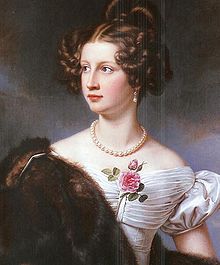Amalie von Lerchenfeld
Amalie Adlerberg ( Russian Амалия Максимилиановна Адлерберг , * 1808 in Regensburg as Amalie Stargard ; † June 21, 1888 in Tegernsee ) was born as illegitimate child of Count Maximilian-Emanuel Lerchenfeld (1772-1809) and Mecklenburg Therese (1772-1809 ) , Princess of Thurn and Taxis . Therese had an affair with the Bavarian diplomat while her husband Karl Alexander stayed in Paris for several years at the invitation of Napoleon Bonaparte .
Life
After the death of her father on October 19, 1809, Amalie joined the von Sternfeld family in Darmstadt , who were related to Therese. She was later brought to Regensburg near her mother. After all, she was brought up by her stepmother von Lerchenfeld with her half-siblings and lived in their Munich palace or in the family castle in Köfering . On August 1, 1823, Ludwig I of Hessen-Darmstadt gave her permission to use the name Amalie von Lerchenfeld . However, she was not allowed to use the family crest or appear in the family tree.
In 1822 Amalie met the young Fyodor Ivanovich Tjuttschew , who had moved from Saint Petersburg to Munich that same year to work in the Russian diplomatic mission abroad. From the love affair that they began with each other, poems by Tjuttschev like tears ( Russian Слёзы ), which were written on the day of an appointment between the two and is most likely dedicated to Amalie , testify . Other of his works, for which he was inspired by Amalie, are An N. ( Russian К Н. ) and I commemorate the golden time… ( Russian Я помню время золотое ).
In addition to Tyuttschew, another diplomat began to be interested in Amalie: Baron Paul Alexander von Krüdener , the Russian embassy attaché in Munich. Amalie preferred the title of nobility and the German-Baltic descent of the older count to the younger Tyuttschew without a title. Maximilian Joseph von Lerchenfeld's letters and diaries illuminate the first years of Tjuttschew's diplomatic activity in Munich (1822–26) and give a picture of his unsuccessful love affair with Amalie, which on January 19, 1825 almost led to a duel with von Krüdener. On August 31, 1825, 17-year-old Amalie von Krüdener married in Köfering. She gave birth to her first child, Nikolai-Arthur, on June 20th / July 2nd, 1826.
Two years later, the young beauty was painted in 1828 by Joseph Karl Stieler , the portraitist of King Ludwig I of Bavaria's Nymphenburg gallery of beauty . Baron von Krüdener died in Stockholm in 1852.
Nikolaus von Adlerberg
She gave birth to an illegitimate child on March 17, 1848, at the age of 40. Father was the 29-year-old Count Nikolaus von Adlerberg . During the Crimean War , Graf von Adlerberg was Governor General of Tauria . Many children lost their parents in the war. The orphans were taken to Simferopol along with wounded soldiers . After the city council failed to found an orphanage , Amalie created a temporary solution for 14 orphans on December 31, 1854 at her own expense. The orphanage was officially established in 1857 and was named after Amalie Adlerberg, who married the Count in 1855. In contrast to all other orphanages in Russia that bore the name of Empress Marija Alexandrovna , the Amalie Adlerberg orphanage kept the original name in the future.
Web links
- Novel about Adlerberg and Tytchev (Russian)
- Amalie Adlerberg on Famous Women (Russian)
- Crimean Ethnographical Museum (formerly Adlerberg Orphan-Asylum) (Russian)
- РОССИЙСКИЕ ДИПЛОМАТЫ БАРОНЫ КРЮДЕНЕРЫ - КОЛЛЕГИ Ф.И. ТЮТЧЕВА (Russian) ( Memento from August 24, 2007 in the Internet Archive )
- Я помню время золотое ... (С. А. Долгополова) (Russian) ( Memento from March 29, 2008 in the Internet Archive )
Individual evidence
- ↑ Martin Dallmeier, Martha Schad: The Princely House of Thurn and Taxis, 300 years of history in pictures . Verlag Friedrich Pustet, Regensburg 1996, ISBN 3-7917-1492-9 , p. 86
- ^ A b Augusta von Oertzen : The beauty gallery of King Ludwig I in the Munich residence . Hanfstaengl, Munich 1923, p. 30.
| personal data | |
|---|---|
| SURNAME | Lerchenfeld, Amalie von |
| ALTERNATIVE NAMES | Adlerberg, Amalie; Sternfeld, Amalie von; Stargard, Amalie (maiden name) |
| BRIEF DESCRIPTION | illegitimate daughter of Therese zu Mecklenburg |
| DATE OF BIRTH | 1808 |
| PLACE OF BIRTH | regensburg |
| DATE OF DEATH | June 21, 1888 |
| Place of death | Tegernsee |
